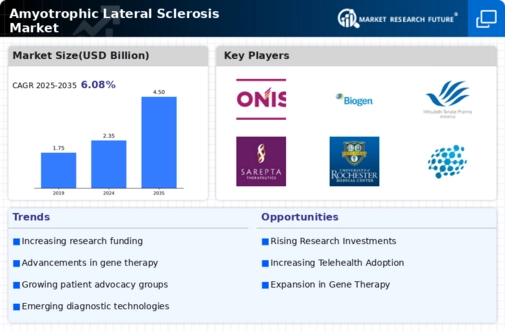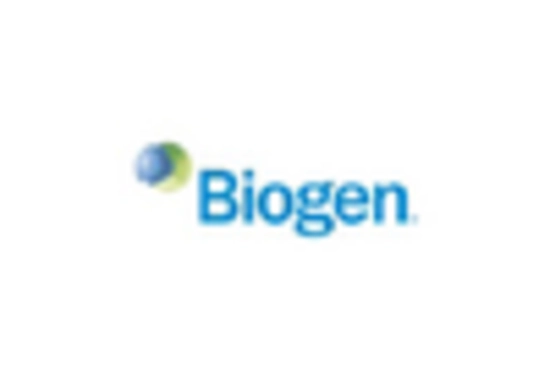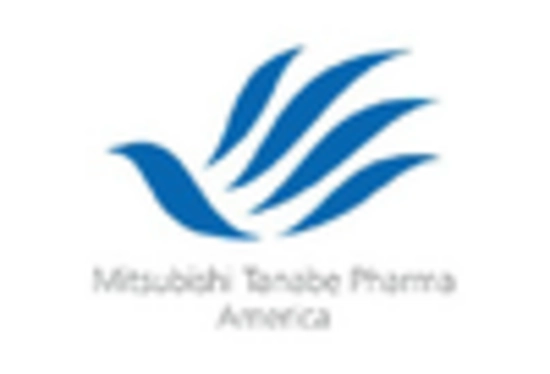Increased Awareness and Advocacy
The heightened awareness and advocacy surrounding Amyotrophic Lateral Sclerosis Market are significantly influencing the Amyotrophic Lateral Sclerosis Market. Various organizations and advocacy groups are actively working to educate the public and healthcare professionals about ALS, its symptoms, and the importance of early diagnosis. This increased awareness is likely to lead to more individuals seeking medical attention, thereby driving demand for diagnostic and therapeutic options. Furthermore, advocacy efforts are fostering collaboration among researchers, healthcare providers, and pharmaceutical companies, which may accelerate the development of new treatments. The growing visibility of ALS in media and public discourse is also contributing to a more informed patient population, which could result in increased participation in clinical trials and research studies. Consequently, the rise in awareness and advocacy is poised to have a profound impact on the Amyotrophic Lateral Sclerosis Market.
Advancements in Research and Development
Ongoing advancements in research and development are crucial for the evolution of the Amyotrophic Lateral Sclerosis Market. The scientific community is increasingly focused on understanding the underlying mechanisms of ALS, which has led to the identification of potential therapeutic targets. Recent breakthroughs in gene therapy and neuroprotective agents have shown promise in preclinical and clinical trials, potentially transforming treatment paradigms. Furthermore, the investment in ALS research has seen a notable increase, with funding from both public and private sectors aimed at accelerating the development of novel therapies. This influx of resources is likely to enhance the pipeline of drugs targeting ALS, thereby expanding treatment options for patients. As a result, the advancements in research and development are expected to play a significant role in shaping the future of the Amyotrophic Lateral Sclerosis Market.
Growing Demand for Supportive Care Services
The demand for supportive care services is on the rise within the Amyotrophic Lateral Sclerosis Market. As ALS progresses, patients often require comprehensive care that includes physical therapy, occupational therapy, and palliative care. The increasing recognition of the importance of holistic care approaches is driving the market for supportive services. According to recent data, nearly 80% of ALS patients utilize some form of supportive care, highlighting the critical need for these services. Additionally, the integration of multidisciplinary care teams is becoming more prevalent, ensuring that patients receive tailored support throughout their disease journey. This growing demand for supportive care not only enhances the quality of life for patients but also creates opportunities for service providers and healthcare organizations to expand their offerings in the ALS market.
Technological Innovations in Treatment Delivery
Technological innovations are reshaping the landscape of the Amyotrophic Lateral Sclerosis Market. The advent of telemedicine and digital health solutions is facilitating remote monitoring and management of ALS patients, thereby improving access to care. These technologies enable healthcare providers to deliver timely interventions and support, which is particularly beneficial for patients in remote areas. Additionally, advancements in assistive devices and communication technologies are enhancing the quality of life for individuals living with ALS. The integration of artificial intelligence and machine learning in treatment protocols is also emerging, potentially leading to more personalized and effective care strategies. As these technological innovations continue to evolve, they are expected to play a crucial role in transforming the management of ALS, ultimately influencing the market dynamics and patient outcomes.
Rising Prevalence of Amyotrophic Lateral Sclerosis
The increasing incidence of Amyotrophic Lateral Sclerosis Market (ALS) is a pivotal driver for the Amyotrophic Lateral Sclerosis Market. Recent estimates suggest that the prevalence of ALS is approximately 2 to 3 cases per 100,000 individuals annually. This rising prevalence is likely to escalate demand for effective treatment options and supportive care services. As the population ages, the number of individuals diagnosed with ALS is expected to grow, thereby intensifying the need for innovative therapies and comprehensive care solutions. The growing awareness of ALS among healthcare professionals and the general public may also contribute to earlier diagnosis and intervention, further impacting the market dynamics. Consequently, the increasing prevalence of ALS is anticipated to significantly influence the market landscape, driving investments in research and development of new therapeutic modalities.


















Leave a Comment